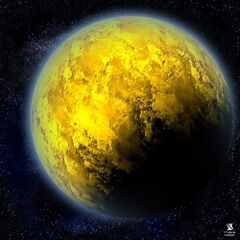
This is what sulfur planet may look like
Sulfur planet (C-class VI, symbol S) is a composition class of planet with surface covered in lakes or oceans of sulfuric acid with sulfuric acid clouds in the atmosphere. As of 2014, four sulfur planets identified: Iamidae (Kepler-52c, P801), Mellona (Kepler-47b, P824), Aita (Tau Ceti e, P849), and Sreng (KIC 5522786 b, P983). Venus has sulfuric acid clouds in the Template:Wpd, but Venus is not considered a sulfur planet because there is not quite enough sulfur on its surface. Instead, much of the surface is covered in solidified lava.
Appearance
Viewed from space, sulfur planet would appear yellow, just like the Template:Wpd sulfur itself as shown in the image. However, the color of clouds can be slightly different depending on their chemistry of condensation nuclei.
Atmosphere
Sulfur planets tend to have similar climates to Earth's, except it uses sulfuric acid as a "variable gas" instead of water vapor as it is on Earth. For example, there are sulfuric acid rain or sulfuric acid snow instead of water rain or water snow. Those planets tend to be warmer than Earth, at around 150°F (66°C). Their atmospheres tend to be composed mostly of nitrogen (N2) and oxygen (O2) with variable amounts of sulfuric acid (H2SO4) and trace amounts of carbon dioxide (CO2), sulfur dioxide (SO2), hydrogen sulfide (H2S), and other gases.
Life
The Template:Wpd-bearing status on sulfur planets are good. Life on sulfur planets is similar to Earth except they use sulfuric acid as a solvent, whereas life on Earth use water as a solvent. Many plants on sulfur planet use photosynthesis using light from the parent star. It is predicted that plants use sulfuric acid (H2SO4) and carbon dioxide (CO2) to produce thioacetic acid (CH3COSH), sulfur dioxide (SO2), and oxygen (O2) using the following balanced equation below:
- 4 H2SO4 + 4 CO2 + energy → 2 C2H4OS + 2 SO2 + 9 O2.
It is also predicted that animals inhale oxygen and exhale carbon dioxide like animals do on Earth. Animals drink sulfuric acid instead of water, and they eat sulfur-rich foods. The main biogeochemical cycle on sulfur planets is the sulfur cycle compared to the carbon cycle here on Earth.
Abundance
There are an estimated 13 billion sulfur planets in Template:Wpd alone, making it three times more abundant than phosphorus planets because sulfur is 70 times more abundant than phosphorus in the universe. This corresponds that 30‰ of all 524 billion terrestrial planets and 16‰ of all 820 billion planets in our galaxy are sulfur planets.
Related links
| ||||||||||||||